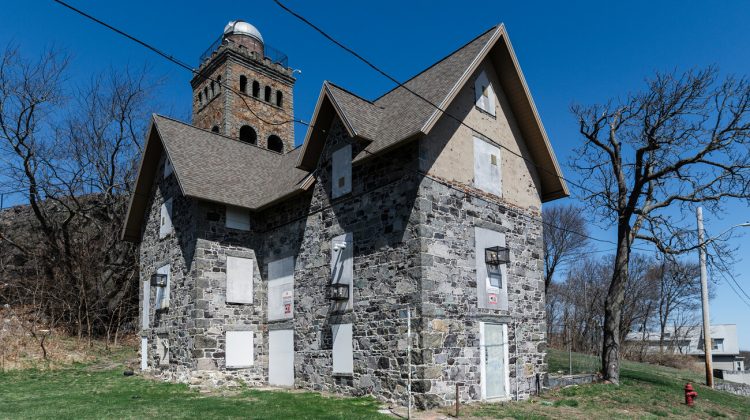LYNN — For generations, High Rock Tower has stood watch over Lynn — once a rallying ground for abolitionists, later a portal to the stars, and always a marker of the city’s imagination.
Through it all, The Daily Item has been there to document its rise, fall, and renewal.
From its early use as a Pawtucket tribal gathering place to its rebirth as a civic landmark in the 20th century, the High Rock Reservation has remained a potent symbol of Lynn’s resilience and imagination. The Item has chronicled nearly every phase of its evolution — from fiery setbacks and telescope installations to park master plans and fresh coats of paint.
One of the earlier archived Item stories dates to December 1905, when the newly built 85-foot stone tower was officially dedicated. It replaced the original wooden observatory erected in 1848 by Jesse Hutchinson, a member of the famed Hutchinson Family Singers — abolitionist performers who turned the rocky summit into a gathering place for progressive ideals, public concerts, and communal reflection.
When the wooden tower burned in 1865, dreams of a lasting public observatory smoldered for decades. Then in 1904, John W. Hutchinson — the last surviving brother — offered to donate the land to the city on the condition that it be preserved as a public park and fitted with a permanent stone tower.
Lynn officials accepted the gift, allocated $15,000 for construction, and completed the new granite structure in 1905, calling it a “grand panoramic gift” to the people.
From its summit, a copper-domed observatory offered views stretching from Nahant to the White Mountains. One European traveler, quoted in a 1912 Item column by historian Nathan Mortimer Hawkes, said the vista rivaled that of the Bay of Naples. Hawkes added that on a summer evening, “The westering sun reddening the placid water of Lynn harbor,” seemed to glorify “the crown of High Rock.”
For the Hutchinsons, the tower was more than a lookout — it was a monument to human rights and harmony. During the 1905 dedication, John W. Hutchinson read a poem invoking his siblings’ legacy and the ideals they proclaimed in song: “Freedom, Reform, Peace; the right of every man to live, and toil, and worship…to live in peace, free from any who would molest or make him afraid.”
The Hutchinson family — Jesse, John, Judson, Asa, and Abby — rose to national fame in the 1840s for their anti-slavery songs and performances in support of social reform. Jesse purchased High Rock in the late 1840s and built the Stone Cottage, then the wooden tower. The family called the area their “Granite State” outpost and envisioned it as a sanctuary for advanced thought and public learning.
Architect Alonzo Lewis, a Lynn abolitionist and poet, is credited with designing the original observatory.
The family’s “Old Granite State” anthem rang out from High Rock on many occasions, and even as the original tower disappeared, the stone cottage remained a lasting relic of the Hutchinson era. The family’s public gatherings drew large crowds, and for a time, the site was a beacon of civic culture and abolitionist spirit.
In the decades following the granite tower’s construction, the site witnessed cycles of decline and revival. Custodians in the 1930s logged visitors from as far as China, Norway, and Chile, though local use remained sporadic. Tower lights and astronomy nights helped preserve some of the tower’s educational mission, but by the 1970s, the area had fallen into disrepair.
A 1986 Sunday Post article noted that previous city investments — including a basketball court installed by the Community Development Department — were destroyed by vandalism. Ward 4 Councilor Robert Tucker said any new proposals would need protection and public buy-in to succeed.
Restoration picked up in the 1990s with federal and state grants. A $230,000 landscaping project in 2006 cleared overgrowth and reconnected Essex Street to the park. In 2011, Lynn received more than $700,000 to install new granite stairs, LED lighting, and a looping path, reclaiming the hill for families, schools, and stargazers alike.
Today, Ford School students, Girls Inc. members, and neighborhood families use the tower as a place for field trips, community walks, and glimpses of Saturn’s rings through the on-site Meade telescope.
This year, the city applied for state funding through the Massachusetts Historical Commission to restore the exterior of the nearby Hutchinson cottage. If approved in June, the project would stabilize masonry, replace decorative roof scrollwork, and look to restore two windows to show what a full rehabilitation could look like.
“There’s no project yet, just an application,” Ivan Gort, the city’s Community Facilities Manager at the Department of Community Development said. “But we’re hopeful. In a perfect world, we could wrap this work in just a few months and open up new conversations about the building’s future.”
This round of work won’t bring the structure up to inhabitable standard, but it’s a critical step toward saving the historic building and potentially opening it to the public down the line.
“We’re doing our best to honor what the Hutchinson family started,” Gort said. “They left us something powerful.”

